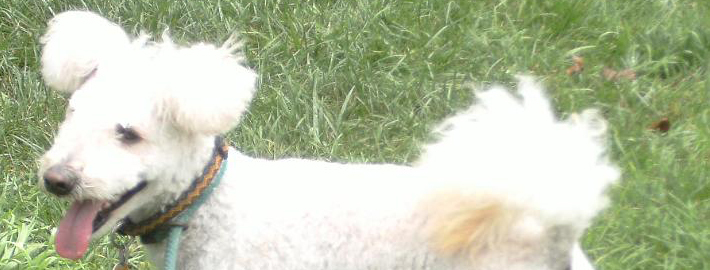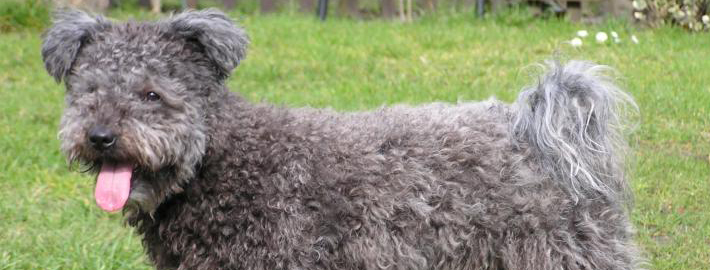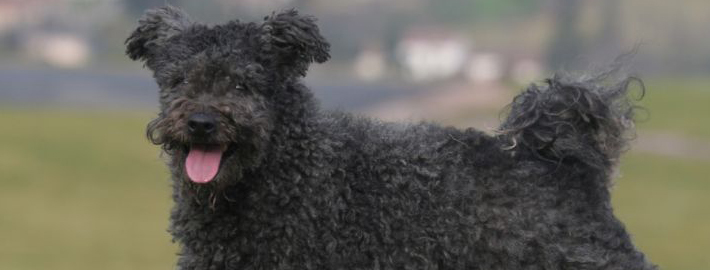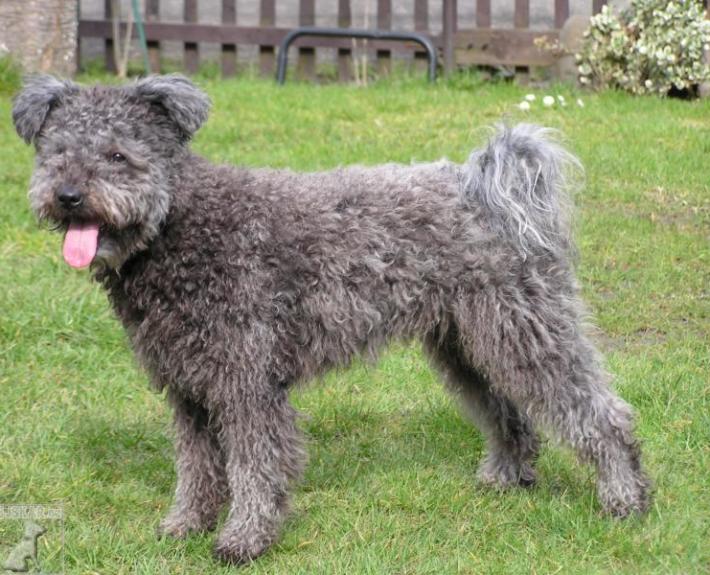What makes the Pumi Unique?
The Pumi is a fast learning, highly trainable, intelligent terrier type herding dog. He is a native breed of Hungary, where he is officially recognized as one of the “National Treasures” of the country. The Pumi breed originates from the Puli, an old Hungarian herding breed, dating back to the nomadic period of the nation, prior to the arrival to the Karpathian-Basin from Central Asia (the Puli is still an active herding breed today) and possible continental terriers, much later during the 17th and 18th century. The Pumi has officially been recognized in Europe since 1920.
Breed Groups
Page Contents
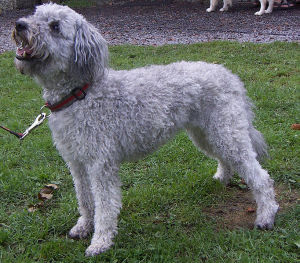
Is the Pumi Right For You?
This very energetic dog is not for people with full schedules or someone who wants a lap pet. Pumik need daily exercise and play and do best in suburban or rural areas. Grooming needs are higher for this breed, but health problems are extremely minimal.
Socialization and regular, reinforced training is important to keep this breed friendly and obedient. The pumi can do well with children and loves the outdoors. If you have the time, attention, and can provide exercise and play every day, you would enjoy having a pumi as your next dog.
In 5 Words
- Lively
- Vocal
- Reserved
- Protective
- Intelligent
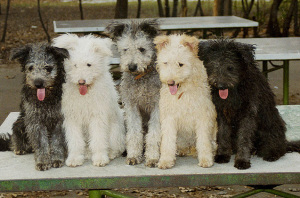
Characteristics
Learn About the Pumi
Description
General Description
The Pumi is a small, highly active, terrier-like sheepdog that hails from Hungary. Pumi puppies are born black and turn varying shades of gray by about 6 to 8 weeks of age. As the dogs get older, they lighten considerably to a color that typically is gauged by the color of their parents. Today’s Pumis have long heads with narrow muzzles, circular tails and short, wiry, curly coats. They should be square in profile. Pumis have lively, whimsical facial expressions that are complimented by their remarkable ears. In fact, the breed’s signature trademark are its large, high-set, stand-up pricked ears, which are longer-haired than the rest of its body and tip over at the top, giving the dog the most alert, endearing appearance possibly of any breed. The Pumi’s eyes are tight, medium-sized, dark, deeply set and gentle in expression.
Size and Weight
The Pumi is not a big dog by any means. Mature males stand between 16 and 18.5 inches at the withers and typically weigh between 22 and 33 pounds. Adult females range from 15 to 17.5 inches in height and normally weigh between 17 and 28.5 pounds. According to some registries, the ideal weight for dogs is 27 to 29 pounds and in bitches, 22 to 24 pounds. Their thick coats are deceiving, making them look heavier and bulkier than they actually are.
Coat and Color
The Pumi’s medium-length double coat is thick, unruly and made up of a combination of wavy and curly hairs that form corkscrew-like tufts all over the body. The top coat is harsh, wavy and wiry. The undercoat is much softer. This shaggy coat makes the Pumi look bulkier than it actually is. It should never be either smooth or corded. Pumi’s eyes and faces are short-haired, but still wavy. Their tails have long feathering ranging up to 5 inches in length. Pumis do require regular maintenance to keep their unusual coats attractive and tidy. Most Pumis are gray. Any shade of gray is highly preferred in the show ring, although black, white, grizzle, rusty brown and fawn (ranging from pale cream to deep mahogany red with gray or black shading) are also acceptable under the American Kennel Club breed standard. The overall appearance must be that of a solid-colored coat. Colors that appear in Pumi litters but are not accepted in most show rings include blue, chocolate, black-and-tan or any patched coat, including piebald. Occasionally, puppies are born wolf-colored.
Short History of the pumi
The pumi is a lesser-known breed from Hungary. Bred from the puli and crossed with German and French dogs in the 1700s, this breed is also believed to have terrier mixed into its heritage. The dogs were developed to drive and herd cattle and other livestock such as pigs and sheep. They are also great watchdogs and exterminators of vermin. The breed’s name first surfaced in 1815.
Temperament
The Pumi can be very protective of its own family, and often slightly reserved toward strangers, so socialization must begin early. The Pumi is a lively and active breed. It is intelligent but barks easily. Pumis are easy to train.
Caring for Your Pumi
General Health
If you cringed at the cost and upkeep of grooming, you’ll be happy about this area. Pumik are extremely health dogs with only a few recurring problems. Hip dysplasia is the most common but still low in frequency. Other conditions include degenerative myelopathy (spinal cord disease) and primary lens luxation (eye lens dislocation). Other than common canine issues, the pumi is one healthy dog!
.
Grooming & Bathing
The coat is curly but does not develop into cords. Shedding is minimal with this breed except when you are brushing the dog — which you should do once every week to two weeks, with full or professional grooming done every three months. Trim the ear hair, clip the nails and brush your pumi’s teeth regularly for optimum health.
Exercise & Training
This breed is the type that demands lots of exercise. They are happiest when made to work in a farm guarding livestock or just helping out whichever way with various chores.

